Due to the US Government shutdown, the Smithsonian is temporarily closed. The Global Volcanism Program website will remain available but will not be monitored or updated. Status updates will be available on the Smithsonian homepage.


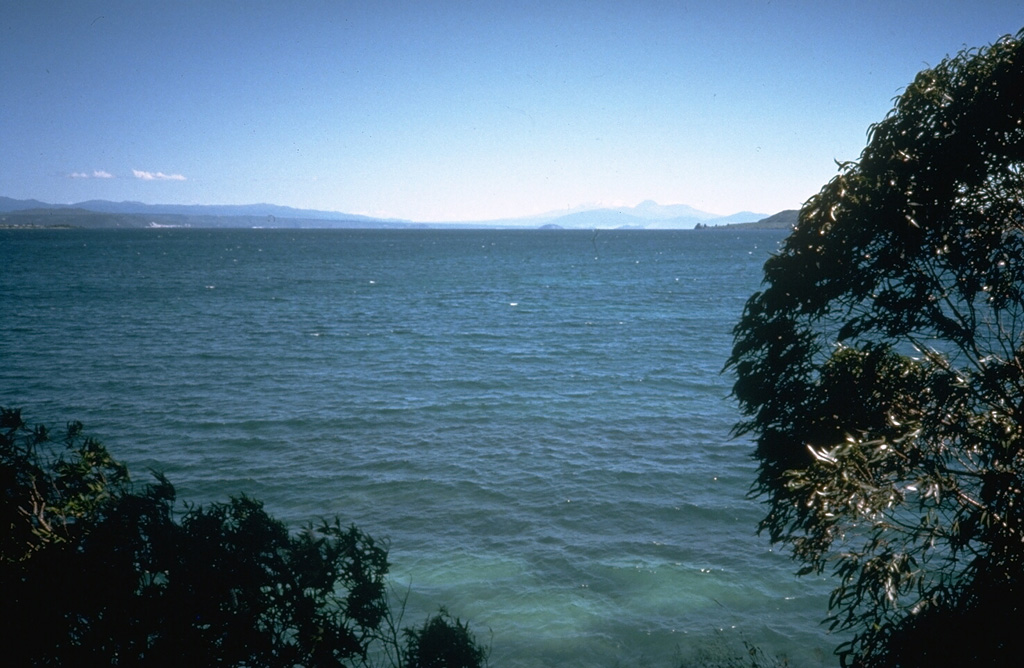
GeoNet reported that earthquake activity and ground deformation at Taupo declined during January-April and returned to background levels in May. The Volcanic Alert Level was lowered to 0 (the lowest level on a six-level scale) on 30 May and the Aviation Color Code remained at Green (the lowest level on a four-color scale). Unrest at the volcano started in early May 2022; during the year there were just over 1,800 earthquakes located beneath the volcano along with ground deformation both on the lake floor and around the lake.
Source: GeoNet
2023: May
2022: September
| November
GeoNet reported that earthquake activity and ground deformation at Taupo declined during January-April and returned to background levels in May. The Volcanic Alert Level was lowered to 0 (the lowest level on a six-level scale) on 30 May and the Aviation Color Code remained at Green (the lowest level on a four-color scale). Unrest at the volcano started in early May 2022; during the year there were just over 1,800 earthquakes located beneath the volcano along with ground deformation both on the lake floor and around the lake.
Source: GeoNet
GeoNet reported that a strong M 5.6 [later revised to 5.7] earthquake occurred beneath Taupo on 30 November. The event was widely felt and caused a small tsunami in the lake. Lake water inundated the shore at several locations, mostly along the N shore, traveling inland as far as 40 m at Wharewaka Point (along the NE shore). Both the earthquake and the tsunami caused minor local damage. The instrument at Horomatangi recorded 250 mm of horizontal ground movement towards the SE, the largest movement ever recorded at that location. Other onshore stations recorded smaller movements of around 10-20 mm. More than 600 aftershocks were located by 7 December, though the magnitude and rate of the events had begun to decline. The largest aftershock was an M 4.5 and two other M 4 events were also recorded.
Earthquakes larger than M 5 beneath Lake Taupo had occurred only four times since 1952, including a M 5 event that occurred on 4 September 2019 as part of a previous period of volcanic unrest. GeoNet noted that there had been 17 previous episodes of unrest at Taupo over the previous 150 years, some more notable than the current episode, and many others before written records. None resulted in an eruption, with the last eruption occurring around 232 CE. The Volcanic Alert Level remained at 1 (the second lowest level on a six-level scale) and the Aviation Color Code remained at Green (the lowest level on a four-color scale).
Source: GeoNet
On 28 September GeoNet reported that seismic unrest and deformation at Taupo continued during the previous week. About 750 earthquakes have been located at depths of 4-13 km beneath the lake since unrest began in May. During the past week the locations were concentrated beneath the E part of the lake and occurred at a slightly lower rate than the week before. An area of deformation at Horomatangi Reef had been rising at a rate of 60 mm (plus or minus 20 mm) per year since May. The data suggested that the seismicity and deformation was caused by the movement of magma and hydrothermal fluids. GeoNet noted that unrest at calderas was common and may continue for months or years without resulting in an eruption; more significant unrest would be indicated by additional indicators of activity and substantial impacts on the local area. The Volcanic Alert Level remained at 1 (the second lowest level on a six-level scale) reflecting “minor volcanic unrest” characterized by ongoing seismicity and inflation.
Source: GeoNet
On 20 September GeoNet raised the Volcanic Alert Level for Taupo to 1 (the second lowest level on a six-level scale) reflecting “minor volcanic unrest” characterized by ongoing seismicity and inflation. Seismicity beneath Lake Taupo began increasing in May. Earthquakes occurred at a rate of about 30 per week but increased to about 40 per week in early September. A M 4.2 earthquake, the largest so far this year, was recorded on 10 September and felt by over 1,000 people. By 20 September over 700 earthquakes had been located with depths less than 30 km, though most ranged 4-13 km. The earthquake locations were in two clusters: a larger cluster beneath the central and E part of the lake, and a smaller cluster to the W centered just offshore from Karangahape. An area of deformation at Horomatangi Reef had been rising at a rate of 60 mm (plus or minus 20 mm) per year since May. The area of uplift corresponded to the main seismic swarm. The data suggested that the seismicity and deformation was caused by the movement of magma and hydrothermal fluids.
GeoNet noted that unrest at calderas was common and may continue for months or years without resulting in an eruption; more significant unrest would be indicated by additional indicators of activity and substantial impacts on the local area. There have been 17 previous episodes of unrest at Taupo over the previous 150 years, some more notable than the current episode, and many others before written records. None resulted in an eruption, with the last eruption occurring around 232 CE. The Volcanic Alert Level change was informed by ongoing analysis of monitoring data, research, and deepening knowledge of past unrest.
Source: GeoNet
The Global Volcanism Program has no Bulletin Reports available for Taupo.
|
|
||||||||||||||||||||||||||||
There is data available for 25 confirmed eruptive periods.
0260 (?) Confirmed Eruption (Explosive / Effusive) VEI: 0
| Episode 1 | Eruption (Explosive / Effusive) | East Lake Taupo (Horomatangi Reefs) | ||||||||||||||||||||||||||||
|---|---|---|---|---|---|---|---|---|---|---|---|---|---|---|---|---|---|---|---|---|---|---|---|---|---|---|---|---|---|
| 0260 (?) - Unknown | Evidence from Correlation: Tephrochronology | ||||||||||||||||||||||||||||
|
List of 4 Events for Episode 1 at East Lake Taupo (Horomatangi Reefs)
|
|||||||||||||||||||||||||||||
0233 Mar 15 ± 13 years ± 20 days Confirmed Eruption (Explosive / Effusive) VEI: 6 (?)
| Episode 1 | Eruption (Explosive / Effusive) | Horomatangi Reefs area, Unit Y | ||||||||||||||||||||||||||||||||||||||||||||||||
|---|---|---|---|---|---|---|---|---|---|---|---|---|---|---|---|---|---|---|---|---|---|---|---|---|---|---|---|---|---|---|---|---|---|---|---|---|---|---|---|---|---|---|---|---|---|---|---|---|---|
| 0233 Mar 15 ± 13 years ± 20 days - Unknown | Evidence from Isotopic: 14C (calibrated) | ||||||||||||||||||||||||||||||||||||||||||||||||
|
List of 8 Events for Episode 1 at Horomatangi Reefs area, Unit Y
|
|||||||||||||||||||||||||||||||||||||||||||||||||
0200 BCE (?) Confirmed Eruption (Explosive / Effusive) VEI: 4
| Episode 1 | Eruption (Explosive / Effusive) | 4 km NW of Te Kohaiakahu Point, Unit X | |||||||||||||||||||||||||||||||||||||||||||
|---|---|---|---|---|---|---|---|---|---|---|---|---|---|---|---|---|---|---|---|---|---|---|---|---|---|---|---|---|---|---|---|---|---|---|---|---|---|---|---|---|---|---|---|---|
| 0200 BCE (?) - Unknown | Evidence from Isotopic: 14C (calibrated) | |||||||||||||||||||||||||||||||||||||||||||
|
List of 7 Events for Episode 1 at 4 km NW of Te Kohaiakahu Point, Unit X
|
||||||||||||||||||||||||||||||||||||||||||||
0800 BCE (?) Confirmed Eruption (Explosive / Effusive) VEI: 2
| Episode 1 | Eruption (Explosive / Effusive) | Ouaha Hills, Unit W | ||||||||||||||||||||||||||||||||||||||
|---|---|---|---|---|---|---|---|---|---|---|---|---|---|---|---|---|---|---|---|---|---|---|---|---|---|---|---|---|---|---|---|---|---|---|---|---|---|---|---|
| 0800 BCE (?) - Unknown | Evidence from Correlation: Tephrochronology | ||||||||||||||||||||||||||||||||||||||
|
List of 6 Events for Episode 1 at Ouaha Hills, Unit W
|
|||||||||||||||||||||||||||||||||||||||
1010 BCE ± 200 years Confirmed Eruption (Explosive / Effusive) VEI: 4
| Episode 1 | Eruption (Explosive / Effusive) | 4 km NW of Te Kohaiakahu Point, Unit V | |||||||||||||||||||||||||||||||||
|---|---|---|---|---|---|---|---|---|---|---|---|---|---|---|---|---|---|---|---|---|---|---|---|---|---|---|---|---|---|---|---|---|---|---|
| 1010 BCE ± 200 years - Unknown | Evidence from Isotopic: 14C (calibrated) | |||||||||||||||||||||||||||||||||
|
List of 5 Events for Episode 1 at 4 km NW of Te Kohaiakahu Point, Unit V
|
||||||||||||||||||||||||||||||||||
1050 BCE (?) Confirmed Eruption (Explosive / Effusive) VEI: 4
| Episode 1 | Eruption (Explosive / Effusive) | 5 km NE of Motutaiko Island, Unit U | |||||||||||||||||||||||||||||||||
|---|---|---|---|---|---|---|---|---|---|---|---|---|---|---|---|---|---|---|---|---|---|---|---|---|---|---|---|---|---|---|---|---|---|---|
| 1050 BCE (?) - Unknown | Evidence from Isotopic: 14C (calibrated) | |||||||||||||||||||||||||||||||||
|
List of 5 Events for Episode 1 at 5 km NE of Motutaiko Island, Unit U
|
||||||||||||||||||||||||||||||||||
1250 BCE (?) Confirmed Eruption (Explosive / Effusive) VEI: 3
| Episode 1 | Eruption (Explosive / Effusive) | 4 km W of Te Kohaiakahu Point, Unit T | ||||||||||||||||||||||||||||
|---|---|---|---|---|---|---|---|---|---|---|---|---|---|---|---|---|---|---|---|---|---|---|---|---|---|---|---|---|---|
| 1250 BCE (?) - Unknown | Evidence from Isotopic: 14C (calibrated) | ||||||||||||||||||||||||||||
|
List of 4 Events for Episode 1 at 4 km W of Te Kohaiakahu Point, Unit T
|
|||||||||||||||||||||||||||||
1460 BCE ± 40 years Confirmed Eruption (Explosive / Effusive) VEI: 6
| Episode 1 | Eruption (Explosive / Effusive) | Horomatangi Reefs?, Unit S | ||||||||||||||||||||||||||||||||||||||
|---|---|---|---|---|---|---|---|---|---|---|---|---|---|---|---|---|---|---|---|---|---|---|---|---|---|---|---|---|---|---|---|---|---|---|---|---|---|---|---|
| 1460 BCE ± 40 years - Unknown | Evidence from Isotopic: 14C (calibrated) | ||||||||||||||||||||||||||||||||||||||
|
List of 6 Events for Episode 1 at Horomatangi Reefs?, Unit S
|
|||||||||||||||||||||||||||||||||||||||
2500 BCE (?) Confirmed Eruption (Explosive / Effusive) VEI: 3
| Episode 1 | Eruption (Explosive / Effusive) | 3 km SW of Motutaiko Island, Unit R | |||||||||||||||||||||||
|---|---|---|---|---|---|---|---|---|---|---|---|---|---|---|---|---|---|---|---|---|---|---|---|---|
| 2500 BCE (?) - Unknown | Evidence from Isotopic: 14C (calibrated) | |||||||||||||||||||||||
|
List of 3 Events for Episode 1 at 3 km SW of Motutaiko Island, Unit R
|
||||||||||||||||||||||||
2600 BCE (?) Confirmed Eruption (Explosive / Effusive) VEI: 4
| Episode 1 | Eruption (Explosive / Effusive) | 3 km NW of Te Kohaiakahu Point, Unit Q | ||||||||||||||||||||||||||||
|---|---|---|---|---|---|---|---|---|---|---|---|---|---|---|---|---|---|---|---|---|---|---|---|---|---|---|---|---|---|
| 2600 BCE (?) - Unknown | Evidence from Isotopic: 14C (calibrated) | ||||||||||||||||||||||||||||
|
List of 4 Events for Episode 1 at 3 km NW of Te Kohaiakahu Point, Unit Q
|
|||||||||||||||||||||||||||||
2800 BCE (?) Confirmed Eruption (Explosive / Effusive) VEI: 3
| Episode 1 | Eruption (Explosive / Effusive) | Unit P | ||||||||||||||||||||||||||||
|---|---|---|---|---|---|---|---|---|---|---|---|---|---|---|---|---|---|---|---|---|---|---|---|---|---|---|---|---|---|
| 2800 BCE (?) - Unknown | Evidence from Correlation: Tephrochronology | ||||||||||||||||||||||||||||
|
List of 4 Events for Episode 1 at Unit P
|
|||||||||||||||||||||||||||||
2850 BCE (?) Confirmed Eruption (Explosive / Effusive) VEI: 3
| Episode 1 | Eruption (Explosive / Effusive) | 2 km S of Te Tuhi Point, Unit O | |||||||||||||||||||||||||||||||||
|---|---|---|---|---|---|---|---|---|---|---|---|---|---|---|---|---|---|---|---|---|---|---|---|---|---|---|---|---|---|---|---|---|---|---|
| 2850 BCE (?) - Unknown | Evidence from Isotopic: 14C (calibrated) | |||||||||||||||||||||||||||||||||
|
List of 5 Events for Episode 1 at 2 km S of Te Tuhi Point, Unit O
|
||||||||||||||||||||||||||||||||||
2900 BCE (?) Confirmed Eruption (Explosive / Effusive) VEI: 4
| Episode 1 | Eruption (Explosive / Effusive) | 5 km NW of Te Kohaiakahu Point, Unit N | |||||||||||||||||||||||||||||||||
|---|---|---|---|---|---|---|---|---|---|---|---|---|---|---|---|---|---|---|---|---|---|---|---|---|---|---|---|---|---|---|---|---|---|---|
| 2900 BCE (?) - Unknown | Evidence from Isotopic: 14C (calibrated) | |||||||||||||||||||||||||||||||||
|
List of 5 Events for Episode 1 at 5 km NW of Te Kohaiakahu Point, Unit N
|
||||||||||||||||||||||||||||||||||
3070 BCE (?) Confirmed Eruption (Explosive / Effusive) VEI: 4
| Episode 1 | Eruption (Explosive / Effusive) | 5 km NW of Te Kohaiakahu Point, Unit M | ||||||||||||||||||||||||||||
|---|---|---|---|---|---|---|---|---|---|---|---|---|---|---|---|---|---|---|---|---|---|---|---|---|---|---|---|---|---|
| 3070 BCE (?) - Unknown | Evidence from Isotopic: 14C (calibrated) | ||||||||||||||||||||||||||||
|
List of 4 Events for Episode 1 at 5 km NW of Te Kohaiakahu Point, Unit M
|
|||||||||||||||||||||||||||||
3120 BCE (?) Confirmed Eruption (Explosive / Effusive) VEI: 3
| Episode 1 | Eruption (Explosive / Effusive) | 2 km W of Te Kohaiakahu Point, Unit L | |||||||||||||||||||||||||||||||||
|---|---|---|---|---|---|---|---|---|---|---|---|---|---|---|---|---|---|---|---|---|---|---|---|---|---|---|---|---|---|---|---|---|---|---|
| 3120 BCE (?) - Unknown | Evidence from Correlation: Tephrochronology | |||||||||||||||||||||||||||||||||
|
List of 5 Events for Episode 1 at 2 km W of Te Kohaiakahu Point, Unit L
|
||||||||||||||||||||||||||||||||||
3170 BCE ± 200 years Confirmed Eruption (Explosive / Effusive) VEI: 4
| Episode 1 | Eruption (Explosive / Effusive) | 4 km NW of Te Kohaiakahu Point, Unit K | |||||||||||||||||||||||||||||||||
|---|---|---|---|---|---|---|---|---|---|---|---|---|---|---|---|---|---|---|---|---|---|---|---|---|---|---|---|---|---|---|---|---|---|---|
| 3170 BCE ± 200 years - Unknown | Evidence from Isotopic: 14C (calibrated) | |||||||||||||||||||||||||||||||||
|
List of 5 Events for Episode 1 at 4 km NW of Te Kohaiakahu Point, Unit K
|
||||||||||||||||||||||||||||||||||
3420 BCE (?) Confirmed Eruption (Explosive / Effusive) VEI: 3
| Episode 1 | Eruption (Explosive / Effusive) | Unit J | ||||||||||||||||||||||||||||
|---|---|---|---|---|---|---|---|---|---|---|---|---|---|---|---|---|---|---|---|---|---|---|---|---|---|---|---|---|---|
| 3420 BCE (?) - Unknown | Evidence from Isotopic: 14C (calibrated) | ||||||||||||||||||||||||||||
|
List of 4 Events for Episode 1 at Unit J
|
|||||||||||||||||||||||||||||
4000 BCE (?) Confirmed Eruption (Explosive / Effusive) VEI: 3
| Episode 1 | Eruption (Explosive / Effusive) | Unit I | |||||||||||||||||||||||||||||||||
|---|---|---|---|---|---|---|---|---|---|---|---|---|---|---|---|---|---|---|---|---|---|---|---|---|---|---|---|---|---|---|---|---|---|---|
| 4000 BCE (?) - Unknown | Evidence from Isotopic: 14C (calibrated) | |||||||||||||||||||||||||||||||||
|
List of 5 Events for Episode 1 at Unit I
|
||||||||||||||||||||||||||||||||||
4100 BCE (?) Confirmed Eruption (Explosive / Effusive) VEI: 4
| Episode 1 | Eruption (Explosive / Effusive) | 4 km WNW of Kohaiakahu Point, Unit H | ||||||||||||||||||||||||||||||||||||||
|---|---|---|---|---|---|---|---|---|---|---|---|---|---|---|---|---|---|---|---|---|---|---|---|---|---|---|---|---|---|---|---|---|---|---|---|---|---|---|---|
| 4100 BCE (?) - Unknown | Evidence from Isotopic: 14C (calibrated) | ||||||||||||||||||||||||||||||||||||||
|
List of 6 Events for Episode 1 at 4 km WNW of Kohaiakahu Point, Unit H
|
|||||||||||||||||||||||||||||||||||||||
4700 BCE (?) Confirmed Eruption (Explosive / Effusive) VEI: 4
| Episode 1 | Eruption (Explosive / Effusive) | East-central Lake Taupo, Unit G | |||||||||||||||||||||||||||||||||
|---|---|---|---|---|---|---|---|---|---|---|---|---|---|---|---|---|---|---|---|---|---|---|---|---|---|---|---|---|---|---|---|---|---|---|
| 4700 BCE (?) - Unknown | Evidence from Isotopic: 14C (calibrated) | |||||||||||||||||||||||||||||||||
|
List of 5 Events for Episode 1 at East-central Lake Taupo, Unit G
|
||||||||||||||||||||||||||||||||||
5100 BCE (?) Confirmed Eruption (Explosive / Effusive) VEI: 3
| Episode 1 | Eruption (Explosive / Effusive) | SE Lake Taupo (Motutaiko Island) (Unit F) | ||||||||||||||||||||||||||||||||||||||
|---|---|---|---|---|---|---|---|---|---|---|---|---|---|---|---|---|---|---|---|---|---|---|---|---|---|---|---|---|---|---|---|---|---|---|---|---|---|---|---|
| 5100 BCE (?) - Unknown | Evidence from Isotopic: 14C (calibrated) | ||||||||||||||||||||||||||||||||||||||
|
List of 6 Events for Episode 1 at SE Lake Taupo (Motutaiko Island) (Unit F)
|
|||||||||||||||||||||||||||||||||||||||
8130 BCE ± 200 years Confirmed Eruption (Explosive / Effusive) VEI: 5
| Episode 1 | Eruption (Explosive / Effusive) | Central, E-central L. Taupo (Opepe), Unit E | |||||||||||||||||||||||||||||||||
|---|---|---|---|---|---|---|---|---|---|---|---|---|---|---|---|---|---|---|---|---|---|---|---|---|---|---|---|---|---|---|---|---|---|---|
| 8130 BCE ± 200 years - Unknown | Evidence from Isotopic: 14C (calibrated) | |||||||||||||||||||||||||||||||||
|
List of 5 Events for Episode 1 at Central, E-central L. Taupo (Opepe), Unit E
|
||||||||||||||||||||||||||||||||||
9210 BCE (?) Confirmed Eruption (Explosive / Effusive) VEI: 4
| Episode 1 | Eruption (Explosive / Effusive) | Acacia Bay lava dome, Unit D | ||||||||||||||||||||||||||||
|---|---|---|---|---|---|---|---|---|---|---|---|---|---|---|---|---|---|---|---|---|---|---|---|---|---|---|---|---|---|
| 9210 BCE (?) - Unknown | Evidence from Correlation: Tephrochronology | ||||||||||||||||||||||||||||
|
List of 4 Events for Episode 1 at Acacia Bay lava dome, Unit D
|
|||||||||||||||||||||||||||||
9240 BCE ± 75 years Confirmed Eruption (Explosive / Effusive) VEI: 5
| Episode 1 | Eruption (Explosive / Effusive) | 4 km W of Te Kohaiakahu Point, Unit C (Poronui) | ||||||||||||||||||||||||||||
|---|---|---|---|---|---|---|---|---|---|---|---|---|---|---|---|---|---|---|---|---|---|---|---|---|---|---|---|---|---|
| 9240 BCE ± 75 years - Unknown | Evidence from Isotopic: 14C (calibrated) | ||||||||||||||||||||||||||||
|
List of 4 Events for Episode 1 at 4 km W of Te Kohaiakahu Point, Unit C (Poronui)
|
|||||||||||||||||||||||||||||
9460 BCE ± 200 years Confirmed Eruption (Explosive / Effusive) VEI: 5
| Episode 1 | Eruption (Explosive / Effusive) | East-central Lake Taupo (Karapiti), Unit B | |||||||||||||||||||||||||||||||||||||||||||
|---|---|---|---|---|---|---|---|---|---|---|---|---|---|---|---|---|---|---|---|---|---|---|---|---|---|---|---|---|---|---|---|---|---|---|---|---|---|---|---|---|---|---|---|---|
| 9460 BCE ± 200 years - Unknown | Evidence from Isotopic: 14C (calibrated) | |||||||||||||||||||||||||||||||||||||||||||
|
List of 7 Events for Episode 1 at East-central Lake Taupo (Karapiti), Unit B
|
||||||||||||||||||||||||||||||||||||||||||||
This compilation of synonyms and subsidiary features may not be comprehensive. Features are organized into four major categories: Cones, Craters, Domes, and Thermal Features. Synonyms of features appear indented below the primary name. In some cases additional feature type, elevation, or location details are provided.
Cones |
||||
| Feature Name | Feature Type | Elevation | Latitude | Longitude |
| Horomatangi Reef | Vent | 38° 51' 0.00" S | 175° 56' 0.00" E | |
Domes |
||||
| Feature Name | Feature Type | Elevation | Latitude | Longitude |
| Ben Lomond | Dome | |||
| Kuharua | Dome | 1129 m | 38° 56' 0.00" S | 175° 42' 0.00" E |
| Manganamu | Dome | 492 m | 38° 59' 0.00" S | 175° 47' 0.00" E |
| Marotiri | Dome | 733 m | 38° 37' 0.00" S | 175° 55' 0.00" E |
| Maunganamu | Dome | 630 m | 38° 44' 0.00" S | 176° 8' 0.00" E |
| Motuapu | Dome | 496 m | 38° 56' 0.00" S | 175° 52' 0.00" E |
| Motukaiko | Dome | 442 m | 38° 52' 0.00" S | 175° 57' 0.00" E |
| Motuma | Dome | 647 m | 38° 38' 0.00" S | 175° 51' 0.00" E |
| Ouaha | Dome | 630 m | 38° 51' 0.00" S | 176° 2' 0.00" E |
| Pukekaikiore | Dome | 748 m | 38° 54' 0.00" S | 175° 44' 0.00" E |
| Rangitukua | Dome | 726 m | 38° 52' 0.00" S | 175° 46' 0.00" E |
| Tahunatara | Dome | 651 m | 38° 43' 0.00" S | 175° 58' 0.00" E |
| Tauhara | Dome | 1087 m | 38° 42' 0.00" S | 176° 10' 0.00" E |
| Tuhingamata | Dome | 661 m | 38° 43' 0.00" S | 176° 0' 0.00" E |
Thermal |
||||
| Feature Name | Feature Type | Elevation | Latitude | Longitude |
| Hipaua | Thermal | 38° 58' 0.00" S | 175° 44' 0.00" E | |
| Tauhara-Taupo | Thermal | 460 m | 38° 41' 31.00" S | 176° 6' 0.00" E |
| Te Hoata | Thermal | |||
| Te Pupu | Thermal | |||
| Tokaanu | Thermal | |||
| Waihi-Tokaanu | Thermal | 915 m | 38° 58' 0.00" S | 175° 46' 0.00" E |
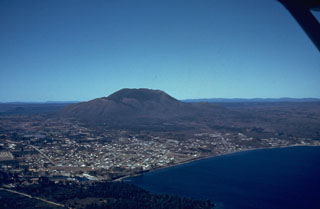 An aerial view shows the E margin of Lake Taupo with Taupo City on its shore. The 35-km-wide caldera is not topographically prominent but has been the source of powerful rhyolitic eruptions from the late Pleistocene throughout the Holocene. The 35,000-year-old Tauhara lava dome forms the peak in the background.
An aerial view shows the E margin of Lake Taupo with Taupo City on its shore. The 35-km-wide caldera is not topographically prominent but has been the source of powerful rhyolitic eruptions from the late Pleistocene throughout the Holocene. The 35,000-year-old Tauhara lava dome forms the peak in the background.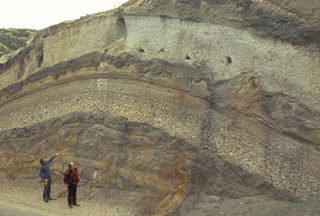 Volcanologists Colin Wilson and Peter Ballance examine a roadcut that dissects deposits of major eruptions from the Taupo volcanic center. The bottom visible unit is an exposure of an unwelded pyroclastic flow deposit from the Oruanui eruption, which formed Taupo's initial caldera about 22,600 years ago. Light-colored pumice fall deposits from other major eruptions are between it and the deposits of the 1,800-year-old Taupo eruption (upper right), which were responsible for Taupo's second caldera.
Volcanologists Colin Wilson and Peter Ballance examine a roadcut that dissects deposits of major eruptions from the Taupo volcanic center. The bottom visible unit is an exposure of an unwelded pyroclastic flow deposit from the Oruanui eruption, which formed Taupo's initial caldera about 22,600 years ago. Light-colored pumice fall deposits from other major eruptions are between it and the deposits of the 1,800-year-old Taupo eruption (upper right), which were responsible for Taupo's second caldera.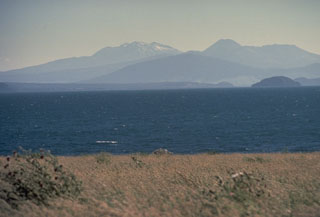 This view looking SW across Lake Taupo, the southernmost major caldera of the Taupo Volcanic Zone, shows several major peaks of Tongariro and Ruapehu. The broad forested peak below the center horizon is the Pleistocene Pihanga volcano. The steep-sided cone on the horizon to its right is Ngāuruhoe, the youngest cone of the Tongariro complex. The broad massif to its right is Tongariro. The snow-capped massif on the left-center horizon is Ruapehu.
This view looking SW across Lake Taupo, the southernmost major caldera of the Taupo Volcanic Zone, shows several major peaks of Tongariro and Ruapehu. The broad forested peak below the center horizon is the Pleistocene Pihanga volcano. The steep-sided cone on the horizon to its right is Ngāuruhoe, the youngest cone of the Tongariro complex. The broad massif to its right is Tongariro. The snow-capped massif on the left-center horizon is Ruapehu. Lake Taupo fills a roughly 35-km-wide caldera that is the site of the most prolific rhyolitic volcano of the Taupo volcanic zone. The caldera was formed during two major explosive eruptions, the Oruanui eruption, roughly 22,600 years ago, and the Taupo eruption, about 1,800 years ago. The latter was one of the world's largest Holocene eruptions. Additional Plinian eruptions during the Holocene have produced widespread airfall pumice deposits.
Lake Taupo fills a roughly 35-km-wide caldera that is the site of the most prolific rhyolitic volcano of the Taupo volcanic zone. The caldera was formed during two major explosive eruptions, the Oruanui eruption, roughly 22,600 years ago, and the Taupo eruption, about 1,800 years ago. The latter was one of the world's largest Holocene eruptions. Additional Plinian eruptions during the Holocene have produced widespread airfall pumice deposits.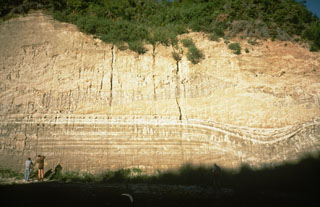 This thick outcrop exposes deposits of the 1,800-year-old Taupo eruption, one of the world's largest during the past 10,000 years. The Taupo eruption produced phreatomagmatic surge deposits, Plinian tephra deposits, and the overlying Taupo ignimbrite, seen at the upper half of this photo above the thin, light-colored layers. The eruption occurred from a vent at Horomatangi Reefs, now submerged beneath Lake Taupo.
This thick outcrop exposes deposits of the 1,800-year-old Taupo eruption, one of the world's largest during the past 10,000 years. The Taupo eruption produced phreatomagmatic surge deposits, Plinian tephra deposits, and the overlying Taupo ignimbrite, seen at the upper half of this photo above the thin, light-colored layers. The eruption occurred from a vent at Horomatangi Reefs, now submerged beneath Lake Taupo.The following 28 samples associated with this volcano can be found in the Smithsonian's NMNH Department of Mineral Sciences collections, and may be availble for research (contact the Rock and Ore Collections Manager). Catalog number links will open a window with more information.
| Catalog Number | Sample Description | Lava Source | Collection Date |
|---|---|---|---|
| NMNH 116210-10 | Pumice | -- | -- |
| NMNH 116210-11 | Pumice | -- | -- |
| NMNH 116210-12 | Ignimbrite | -- | -- |
| NMNH 116210-23 | Ignimbrite | -- | -- |
| NMNH 116210-24 | Ignimbrite | -- | -- |
| NMNH 116210-25 | Ignimbrite | -- | -- |
| NMNH 116210-28 | Welded Ignimbrite | -- | -- |
| NMNH 116210-29 | Welded Ignimbrite | -- | -- |
| NMNH 116210-30 | Ignimbrite | -- | -- |
| NMNH 116210-32 | Ignimbrite | -- | -- |
| NMNH 116210-33 | Ignimbrite | -- | -- |
| NMNH 116210-34 | Basalt | -- | -- |
| NMNH 116210-35 | Rhyolite | -- | -- |
| NMNH 116210-37 | Ignimbrite | LAKE TAUPO | -- |
| NMNH 116210-38 | Ignimbrite | LAKE TAUPO | -- |
| NMNH 116210-4 | Ignimbrite | -- | -- |
| NMNH 116210-5 | Ignimbrite | -- | -- |
| NMNH 116210-6 | Airfall Pumice | -- | -- |
| NMNH 116210-7 | Pumice | -- | -- |
| NMNH 116210-8 | Ignimbrite | -- | -- |
| NMNH 116210-9 | Volcanic Ash | -- | -- |
| NMNH 116566-12 | Volcanic Rock | TAUHARA | -- |
| NMNH 116691-5 | Pyroclastic Rock | -- | 1 Feb 1986 |
| NMNH 116691-9 | Pyroclastic Rock | -- | -- |
| NMNH 117454-55 | Pumice | -- | -- |
| NMNH 117454-56 | Obsidian | -- | -- |
| NMNH 117454-57 | Obsidian | Taupo breccia | -- |
| NMNH 117551-15 | Obsidian | Tauhara 'dacite' flow; Tauhara | -- |
| Copernicus Browser | The Copernicus Browser replaced the Sentinel Hub Playground browser in 2023, to provide access to Earth observation archives from the Copernicus Data Space Ecosystem, the main distribution platform for data from the EU Copernicus missions. |
| MIROVA | Middle InfraRed Observation of Volcanic Activity (MIROVA) is a near real time volcanic hot-spot detection system based on the analysis of MODIS (Moderate Resolution Imaging Spectroradiometer) data. In particular, MIROVA uses the Middle InfraRed Radiation (MIR), measured over target volcanoes, in order to detect, locate and measure the heat radiation sourced from volcanic activity. |
| MODVOLC Thermal Alerts | Using infrared satellite Moderate Resolution Imaging Spectroradiometer (MODIS) data, scientists at the Hawai'i Institute of Geophysics and Planetology, University of Hawai'i, developed an automated system called MODVOLC to map thermal hot-spots in near real time. For each MODIS image, the algorithm automatically scans each 1 km pixel within it to check for high-temperature hot-spots. When one is found the date, time, location, and intensity are recorded. MODIS looks at every square km of the Earth every 48 hours, once during the day and once during the night, and the presence of two MODIS sensors in space allows at least four hot-spot observations every two days. Each day updated global maps are compiled to display the locations of all hot spots detected in the previous 24 hours. There is a drop-down list with volcano names which allow users to 'zoom-in' and examine the distribution of hot-spots at a variety of spatial scales. |
|
WOVOdat
Single Volcano View Temporal Evolution of Unrest Side by Side Volcanoes |
WOVOdat is a database of volcanic unrest; instrumentally and visually recorded changes in seismicity, ground deformation, gas emission, and other parameters from their normal baselines. It is sponsored by the World Organization of Volcano Observatories (WOVO) and presently hosted at the Earth Observatory of Singapore.
GVMID Data on Volcano Monitoring Infrastructure The Global Volcano Monitoring Infrastructure Database GVMID, is aimed at documenting and improving capabilities of volcano monitoring from the ground and space. GVMID should provide a snapshot and baseline view of the techniques and instrumentation that are in place at various volcanoes, which can be use by volcano observatories as reference to setup new monitoring system or improving networks at a specific volcano. These data will allow identification of what monitoring gaps exist, which can be then targeted by remote sensing infrastructure and future instrument deployments. |
| Volcanic Hazard Maps | The IAVCEI Commission on Volcanic Hazards and Risk has a Volcanic Hazard Maps database designed to serve as a resource for hazard mappers (or other interested parties) to explore how common issues in hazard map development have been addressed at different volcanoes, in different countries, for different hazards, and for different intended audiences. In addition to the comprehensive, searchable Volcanic Hazard Maps Database, this website contains information about diversity of volcanic hazard maps, illustrated using examples from the database. This site is for educational purposes related to volcanic hazard maps. Hazard maps found on this website should not be used for emergency purposes. For the most recent, official hazard map for a particular volcano, please seek out the proper institutional authorities on the matter. |
| IRIS seismic stations/networks | Incorporated Research Institutions for Seismology (IRIS) Data Services map showing the location of seismic stations from all available networks (permanent or temporary) within a radius of 0.18° (about 20 km at mid-latitudes) from the given location of Taupo. Users can customize a variety of filters and options in the left panel. Note that if there are no stations are known the map will default to show the entire world with a "No data matched request" error notice. |
| UNAVCO GPS/GNSS stations | Geodetic Data Services map from UNAVCO showing the location of GPS/GNSS stations from all available networks (permanent or temporary) within a radius of 20 km from the given location of Taupo. Users can customize the data search based on station or network names, location, and time window. Requires Adobe Flash Player. |
| DECADE Data | The DECADE portal, still in the developmental stage, serves as an example of the proposed interoperability between The Smithsonian Institution's Global Volcanism Program, the Mapping Gas Emissions (MaGa) Database, and the EarthChem Geochemical Portal. The Deep Earth Carbon Degassing (DECADE) initiative seeks to use new and established technologies to determine accurate global fluxes of volcanic CO2 to the atmosphere, but installing CO2 monitoring networks on 20 of the world's 150 most actively degassing volcanoes. The group uses related laboratory-based studies (direct gas sampling and analysis, melt inclusions) to provide new data for direct degassing of deep earth carbon to the atmosphere. |
| Large Eruptions of Taupo | Information about large Quaternary eruptions (VEI >= 4) is cataloged in the Large Magnitude Explosive Volcanic Eruptions (LaMEVE) database of the Volcano Global Risk Identification and Analysis Project (VOGRIPA). |
| EarthChem | EarthChem develops and maintains databases, software, and services that support the preservation, discovery, access and analysis of geochemical data, and facilitate their integration with the broad array of other available earth science parameters. EarthChem is operated by a joint team of disciplinary scientists, data scientists, data managers and information technology developers who are part of the NSF-funded data facility Integrated Earth Data Applications (IEDA). IEDA is a collaborative effort of EarthChem and the Marine Geoscience Data System (MGDS). |